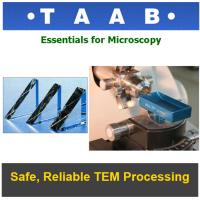 Add My Company
Add My Company
Sign In
Safe and reliable TEM processing
19-12-2019

Introduction
From time to time we all have embedding problems even though we have been using a protocol for years. The following tips are the result of years of investigating difficulties experienced during the embedding of specimens for TEM. It is not always the technique nor the resin that is at fault. Whether using an automated processor or processing by hand occasional difficulties may occur. Checking back in the chemical supply chain can sometimes be beneficial - perhaps the reagents have unknowingly been sourced from a different supplier or have been longer in central stores than normal.
Fixation
Due to the relatively slow rate that fixatives penetrate into tissue, specimens must be kept as small as possible, no more than 1mm in at least one direction. If tissues are soft and difficult to cut it is worth fixing for some time in glutaraldehyde which will not only fix but also harden the tissue allowing smaller pieces to be achieved. This will assist the action of slower secondary fixatives such as OsO4 . Fixatives can be hazardous as they are used for their property of killing and stabilising cells. However, at TAAB we do try to minimise handling procedures, so we offer fixative solutions in ampoules or bottles eliminating the dissolving of crystals where possible. You will still need to work under a fume hood or an extraction system.
Dehydration
This step is vitally important and normally required for most embedding media although we do offer water miscible resins such as Lemix (L029) and Durcupan (D033)) in which the monomer can be used for dehydration steps. This eliminates the requirement of using of alcohol, acetone or propylene oxide. The water miscible monomers are considered less aggressive agents for dehydration. Poor dehydration can manifest itself as soft blocks, holes in the tissue or sections expanding more than normal in the water bath of the ultramicrotome. All dehydrating agents (and most resin monomers) require removal of all water from the specimen to be effective. This means that they must be dry to start with and maintained that way. If obtaining "absolute" alcohol from a central supply do not assume it will 100% dry, it almost certainly won't be. Store it in small (not more than 250ml) bottles over silica gel and/or molecular sieve. Every time you use some replace it so that there is no air over the contents.
M032 Molecular sieve type 3A 500g
S042 Silica gel self-indicating 500g
To prevent the molecular sieve or silica gel dispersing into the reagent you can contain it in a length of dialysis tubing.
Embedding Media
Many EM embedding media have toxicity, and/or carcinogenic issues. To minimise user contact TAAB offers most of our own resins as Pre-mix kits. All measuring or weighing is done in-house at TAAB and all the customer needs to do is mix the components together in the bottles provided so there is no contact and no cleaning-up afterwards. Any remaining resin can polymerised within the bottles and disposed of in normal waste. Acrylic resins such as Unicryl or London Resin are less toxic but are flammable.
Our own epoxy resins such as TAAB Embedding Resin (T004/1) or TLV (TAAB Low Viscosity Resin (T049)) can be dehydrated using alcohol alone, but it must be completely dry (see dehydration above) thus eliminating the use of the more dangerous acetone or propylene oxide. Resin monomers unopened have an indefinite shelf life, but once opened should be used ASAP. The resin is liable to absorb moisture and/or CO2 from the atmosphere which can affect the curing properties. Most importantly, the accelerator or initiator must be fresh as they have short shelf lives. It may be useful to date stamp these items when they arrive in your lab. Maximum shelf lives should be considered as follows:
DMP30 and S1 6months
BDMA 12 months
Diamond knives will often enable sectioning of imperfectly embedded specimens impossible with glass knives, and may be one way to recover irreplaceable samples (see our Diatome range), but they should not supplant investigation of the basic problem.
Section staining
The normal procedure is to post stain with uranyl acetate followed usually by Reynold’s lead citrate. The uranyl acetate, although manufactured from depleted uranium has a small amount of radioactive hazard and is discouraged in some labs. We can offer two alternatives both of which are non-radioactive but are to some degree toxic. These, in current user preference order are, Uranyless (S474) and TAAB EM Stain 336 (S472).
We also provide a ready-made solution of Reynold’s lead citrate stain in an airtight dispenser which eliminates handling of lead solutions (L037).
Whist we try where possible to reduce operating hazards to the user there is no substitute for Good Laboratory Practice and common sense.
The above information is necessarily brief and may not cover every problem. Please contact us should you require any further assistance.
For more information on Safe and reliable TEM processing talk to TAAB Laboratories Equipment Ltd
Enquire Now
List your company on FindTheNeedle.

